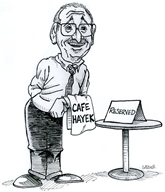The great Thomas Sowell speaks out against Trump’s disastrous trade ‘policy.’ A slice:
Thomas Sowell: It’s painful to see a ruinous decision from back in the 1920s being repeated.
[DBx: Note that Sowell said this on April 1st, before Trump’s “Liberation Day” announcement. It’s very likely that had Sowell known on April 1st just what was going to happen on the afternoon of April 2nd, his words of opposition would have been even harsher.]
Markets around the world spent Thursday absorbing the historic magnitude of Mr. Trump’s tax on commerce. Evercore ISI estimates that Wednesday’s news will raise the U.S. effective tariff rate to 24%, and 27% if he goes ahead with the sectoral tariffs he promises on drugs, copper and more. That’s higher than after the Smoot-Hawley tariff of 1930.
Worse is the bizarre, slapdash way the White House calculated the tariff rates on individual countries. Everyone will pay 10%. Then the White House appears to have calculated each country’s additional tariff rate by dividing its trade deficit with the U.S. by its exports to the U.S. This rate was then cut in half for most countries, which Mr. Trump calls a “discount.” The discordant result is that U.S. adversaries like Iran (10%) and Venezuela (15%) will pay lower rates than friends in Europe (20%), Japan (24%) and Taiwan (32%).
The trade deficit is a long-time Trump fixation that he sees as a zero-sum game. Trade-deficit countries must be cheating somehow, but then what about countries like the U.K. and Australia that have a trade deficit with the U.S.? Why hit them with a 10% tariff?
…..
Yet Mr. Trump claims his tariffs will unleash a flood of new investment in the U.S. Then why is the dollar falling in value (see nearby), recording its worst single-day loss in two years? Our guess is that investors are losing confidence in U.S. economic decisions.
…..
The Trump tariffs ironically will punish companies that have moved manufacturing out of China to other countries in Southeast Asia, which his first Administration encouraged them to do. About half of Nike’s shoes are now made in Vietnam versus 18% in China.
Mr. Trump hits Vietnam with a 46% tariff, which means Nike will have to rethink where to make low-margin shoes. Mr. Trump seems to think they should be made in America. Mr. Trump’s tariffs may have the U.S. investing to create jobs in shoe-making when it should invest in AI. This misallocation of capital will not make the U.S. more competitive against China.
…..
There is also the not-so-small matter of the rule of law. Mr. Trump justifies his tariffs by declaring a national emergency under the 1977 International Emergency Economic Powers Act. No previous President has used that law to impose tariffs. Mr. Trump is stretching his authority much as Joe Biden did with his student-loan forgiveness.
…..
Mr. Trump’s tariffs are the biggest policy shock to the world trading system since Richard Nixon blew up Bretton Woods in 1971. As with that decision, Mr. Trump is acting with little understanding about the damage his tariffs will cause. The “disturbance” might not be as little as he imagines.
Tad DeHaven has candidates for the “five most absurd things about Trump’s ‘reciprocal’ tariffs.” A slice:
While these items may offer a chuckle, there’s nothing funny about the president of the United States having the power to blow up the global economy just because he doesn’t understand how trade works.
Christian Britschgi tells of just how utterly mindless are Trump’s “Liberation Day” tariffs.
Charles Calomiris urges Republicans to “save Trump from his tariffs.” Two slices:
The tariff policy announced by President Trump could be the most consequential action of his presidency. The new tariffs will have disastrous economic and political consequences and undo the many good policy ideas that the Administration has enacted or advocated. They are a political dream come true for Bernie Sanders and the Chinese Communist Party. At a moment when the feckless Democrats are unable to find a path to a viable future, and when China’s economic growth and international influence are in steep decline, these tariffs will help to revive the Democratic Party and push other countries into the arms of China.
…..
Some will read all this and say: “But this is a strategic ploy to restore free trade. We need to impose these tariffs as a matter of principle, to stop the unfair trade practices of other countries that the President described in his Rose Garden speech. And the President assured us that the tariffs only go part of the way toward addressing those unfair trade practices (demonstrating his kindness). Furthermore, as the President said, if countries reduce their trade barriers, the new tariffs will be reduced.” All of those statements are demonstrably false.
Are the new tariffs “reciprocal” or “kind,” as the President has characterized them? First, note that a minimum tariff of 10% has been imposed on countries irrespective of their policy stance or any other facts. That simple fact reveals that the purpose of the tariffs is to reduce trade, not to be reciprocal.
For many countries, the tariff rates set by the President are much higher than 10%. He claims that this reflects their own tariffs and other non-tariff barriers to U.S. exports. To be specific, the Administration is claiming that the tariff rate of 46% on Viet Nam is set at roughly half of the tariff-equivalent trade barriers the Administration’s economists calculate that Viet Nam imposes on the U.S. The fact that it is “half” is supposed to indicate the “kindness” of the new tariff policy.
But the calculations are fatuous, and laughably absurd to anyone with a simple understanding of the arithmetic of trade and capital flows. The Administration economists assume that the only reason for a country to have a trade deficit with the U.S. is an unfair trade practice by the country (which could include quotas, value-added-tax exemptions, or currency manipulation). It is possible – even likely – that for many countries, most of the explanation for their trade surpluses with the U.S. is some or all of those practices, and the President was right to point to examples of some of those in his remarks.
Despite the president’s rhetoric about “reciprocity,” the White House’s numbers immediately didn’t add up. While the US and EU don’t have a free trade agreement, there is no way the average tariff rate the EU charges the US is 39 percent. And for South Korea, who we do have a free trade agreement with, Trump’s chart claimed they are charging us a 50 percent tariff rate. In fact, many of the countries that Trump singled out for “reciprocal” tariffs score above the United States on conventional measures of trade freedom.
The White House chart did say that the figures include “currency manipulation and trade barriers,” and initially it seemed there was some sophisticated formula being used to calculate the rates. Not so. As several users on X/Twitter quickly figured out, and the White House later confirmed, their “reciprocity” formula is a simple one. It’s also nonsensical from an economic standpoint.
According to the White House’s calculations, Trump is claiming the “tariff” a country is charging the US is equal to the trade deficit between the countries, divided by the imports into the US (for goods only, not services). He then sets his “reciprocal” rate according to this back-of-the-envelope formula.
Many things about the Trump administration’s new global tariffs make little sense.
Those tariffs are a huge tax increase on American consumers and businesses—one that will raise taxes by $1.8 trillion and lower incomes by over 2 percent, according to the Tax Foundation’s analysis. The White House seems to have used some fuzzy math in calculating those tariff rates. Trump is also, somehow, putting tariffs on countries inhabited solely by penguins—which has, in fairness, spurred robust growth in the manufacturing of memes. It is all very silly and largely self-destructive.
Yet, even by those standards, some of these new tariffs are truly outlandish. In the interest of narrowing down the chaos into a few bite-sized morsels, here are the three country-specific tariffs that make the least sense, based on what Trump himself has said are the guiding principles behind his new trade policies.
“Liberation day” has arrived. Unfortunately, it threatens to liberate Americans from robust real wage growth, low unemployment and a good chunk of their retirement savings.
Trump’s tariffs are an economic emergency. If implemented, the US’s average tariff rate would be higher than under Smoot-Hawley. They would constitute the largest tax increase since the 1968 levies to fund the Vietnam war. Our trade partners would retaliate. By raising taxes and prices, they would erode household income and spending. Business investment spending and US exports would be hit hard. If sustained, this trade war would be likely to cause a recession.
And for what? Around half of US imports are intermediate goods used domestically to produce final ones. High tariffs raise the costs of production for US companies, hurting competitiveness. Take steel. For every one job in US steel production, there are 80 that use steel in production. Trump’s tariffs might indeed help that one steel producer, but they will hurt the 80 others by reducing the competitiveness of their employers.
The economists Aaron Flaaen and Justin Pierce estimate that during Trump’s first-term trade war, the manufacturing employment losses from higher input prices were five times as large as the gains from import protection. In addition, the losses from retaliation were nearly three times as large as gains from import protection.
Peter Earle busts a myth peddled by Treasury secretary Scott Bessent.



